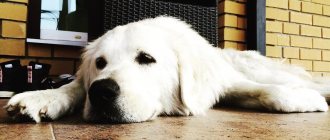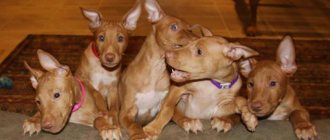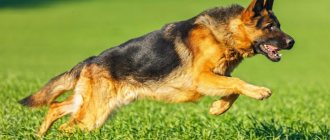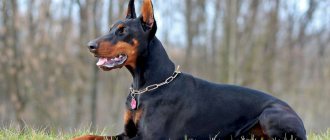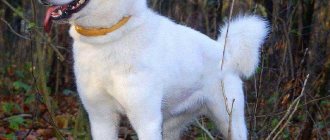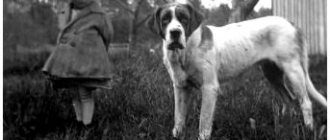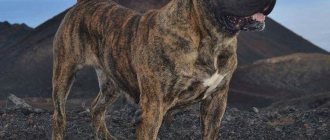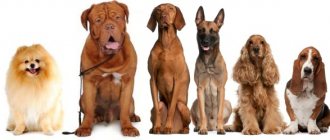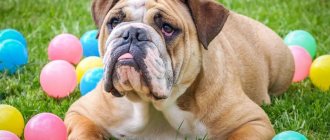The Slovak Chuvach is an ancient herding breed. After meeting a guy, you give him your heart for life. The animal contains complete harmony - splendor and complexion, prudence and courage, spiritual traits and unpretentiousness in care.
The Slovak Chuvach (Slovakian: Slovenský čuvač) is a breed of dog used as a livestock guard. This breed was developed in the 17th century in the mountainous regions of former Czechoslovakia. After World War II, these dogs were on the verge of extinction, but dog handler Antonin Grudo restored this breed. These dogs are also used as guard dogs and rescue dogs. The Slovakian Chuvach is also great for family life and is attached to all family members.
Slovak dude photo
Description
Another name for the aboriginal breed is Tatra dogs; previously they were popular in the Tatra Mountains, Carpathians, Alps, and Balkans.
In these areas they have helped herd flocks of sheep since the 17th century, vigilantly protecting the livestock from wolves, bears, lynxes and intruders. There is no exact information about the origin of the defender. There is a scientific version about the relationship between the snowman dog and the polar wolf. Interesting fact
The mountaineer can perfectly distinguish odors at a distance of 30 meters, which is why it is called Chuvach.
Interesting fact
A Balkan man quickly digs food out from under a meter-long layer of snow.
Interesting fact
Emphasizing the vigilance of the aborigine, they say about the lively creature: “Sleeps with half an ear.”
Breed Features
According to dog breeders who keep snow beauties, the breed has not become widespread due to a lack of information about its advantages. These are non-aggressive bodyguards who can valiantly protect the house and all its inhabitants, including other animals.
Acute hearing and a keen sense of smell help quadrupeds do their work. Therefore, the bodyguard senses danger and predators a mile away, that is, before anyone else. In addition, the watchman easily gets along with cats, birds, small and large four-legged animals.
The Balkan is very kind to children, is able to nurse preschoolers, happily shares children's pranks, rushes around the garden or meadow with the boys, cheerfully participating in outdoor games.
But two-year-old foolish children should not be left with a giant, because children at this age have not yet learned the rules of behavior with a wayward “uncle dog” who can inadvertently injure the children.
Distinctive features
Head
Large, oblong. The wide forehead is divided by a clearly visible furrow. The muzzle is decorated with a black movable lobe.
Jaws
Strong with correct bite.
Ears
Triangular, medium-sized. Set on high. Hangs down to jaw level.
Eyes
Oval, small, placed at a medium distance. The iris is brown.
Torso
Massive, muscular. The neck and back are straight. The croup is sloping and powerful. The tail is well covered with elongated hair, set low, touching the hock joints when at rest.
Paws
Straight, muscular, strong.
Wool
The outer coat is 5-15 cm, hard, the undercoat is soft and thick. Strictly white in color, yellowness is allowed only near the ears.
Character
The Highlander has a dual nature. He is vigilant, ferocious towards his enemies and affectionate and sociable with his household. He does not attack first, at first he tries to scare off the stranger with grins, growls, barks, lunges, and only after that he rushes into battle, even if the opponent is stronger than the restless one.
An aborigine, without a command, always guards the house, territory, monitors the safety of household members and family friends. He won’t sleep a wink and won’t calm down until everyone gets together. He becomes attached to all family members, but it is better to be trained by one person who is strong in spirit and experienced in cynology. The Slovak perceives him as a leader.
Without proper upbringing, a Tatra can be stubborn, self-willed, makes decisions on his own, and is cunning in order to avoid following commands. But with a consistent approach:
- learns tricks easily;
- willingly obeys;
- capable of performing the functions of a bloodhound, security guard, border guard;
- protects from insidious “friends”.
Chuvach is a Slovakian shepherd dog
The main functionality of a shepherd dog in mountainous areas is to keep an eye on the sheep, sometimes gather them into a bunch, and the main thing is to not allow them to come close to a flock of predatory animals, to be on the alert all the time, sniff and listen. If you detect suspicious moments, react immediately - make noise and call the shepherdess. The dude is always vigilant and keeps his ears open. The shepherd is present, but he cannot keep up with everything at once. Malicious enemies do not sleep. One can only envy the courage of a shepherd dog, which has no instinct of self-preservation. They got into fights with wolves, and sometimes with bears - their character traits were hardened in unequal battles.
The unusual pure white color of the dog is also not without reason. In the dark, it allows her to stand out. When someone attacks, the shepherd runs to the helper’s barking and can fire several times from a weapon
And here the most important thing is not to shoot the dog. White is actually the most optimal color for a herding dog.
Description of the Slovak dude
The current FCI standard for the Slovakian Chuvach breed was adopted in 1996. He classifies Chuvach dogs into the first group (guard and racing dogs) and its first section (shepherd dogs without working tests).
Appearance
In the company of white European shepherd dogs, the Slovakian Dude is the smallest and highest-legged. But everything is relative - the natural power and stamina of this dog make an excellent impression, forming the image of a person’s reliable friend, strong and selfless.
Dudes attract people with their intelligence, devotion and, of course, beauty
Table: exterior of the Slovak Chuvas according to the FCI standard
| Main articles | Description |
| Height |
|
| Weight |
|
| Body |
|
| Head |
|
| Paws |
|
| Tail |
|
| Wool |
|
The dude moves very beautifully and is always willing to play
Character and behavior
Owners of dudes claim that it is impossible to find a better guard - in addition to strength, courage and tirelessness, these dogs have a unique quality encrypted in the very name of the breed. The sensitive dude knows how to protect even when he... is sleeping, so you will be under his watchful care all day long.
This dog can guard even in his sleep
Slovaks tell legends about the devotion of a Chuvach to his owner. And indeed, unlike purely territorial herding dogs (Caucasians or Alabais, for example), this dog is very human-oriented, ready to protect him at any time and from any danger, without hesitation to sacrifice his own life for this.
The dude just loves children
Children in the family are the dude’s definite favorites; he is ready to constantly protect them from the slightest danger, tolerate children’s activity and even unceremoniousness. He perceives other pets in the house as the owner's property, which must be protected and not damaged under any circumstances - even if he really wants to.
The dude prefers not to quarrel and maintain good neighborly relations with all the inhabitants of the house
Disqualifying faults
A Slovakian Dude may be disqualified at an exhibition and removed from breeding if an expert discovers the following defects in him:
- aggressive or cowardly behavior;
- pink spots on the nose, lips, eyelids;
- eyes too light;
- yellow spots on the skin;
- cryptorchidism;
- tail creases.
The standard for an exhibition dude is the basic law
Veterinary
Native breeds are usually distinguished by excellent health and trouble-free reproduction of offspring. This is another compelling argument in favor of choosing a Slovakian Dude dog for yourself.
Diseases and vaccinations
The genetics of Slovakian Chuvaches are wonderful - they are very healthy dogs, but recently some of the costs of illiterate breeding have begun to negatively affect the health of the offspring. Fortunately, Chuvaches, unlike many other breeds, do not have specific hereditary diseases and pathologies, but cases of a tendency to allergies have already been recorded (white dogs generally suffer from this more often than all others) and problems characteristic of large breeds - hip dysplasia and gastric volvulus.
Try to initially rule out bad heredity - when choosing a puppy, ask for x-rays to check for the presence of dysplasia in its parents, at least visually assess the condition of the mother’s skin and mucous membranes
Constantly monitor your dog’s physical condition both during the critical growing period and as an adult:
- To prevent such a dangerous pathology as gastric volvulus, do not give your dog too large a portion of food at once and do not allow it to actively move for an hour after eating.
- Carefully monitor the condition of the joints - dysplasia can be not only hereditary, but also acquired as a result of improper cultivation.
- Support the formation of the growing dog's bones with special supplements - glucosamines and chondroetins; Calcium is also very useful, but it is important to strictly follow its dosage.
- Avoid putting excessive stress on the joints until the dog reaches one or even one and a half years of age, depending on the size of the individual.
Timely vaccination is an immutable rule for keeping any dog. There are several vaccination schedules for puppyhood. In this sense, different veterinarians have their own preferences. Usually, the first complex vaccinations are given at eight and twelve weeks of age; parasites must be cleared ten days before each vaccination. For the second vaccination, at three months of age, a rabies vaccine is added to the usual complex.
Vaccination is carried out annually. Only healthy animals can be vaccinated. A ten-day (or at least a week) quarantine after vaccination is required.
Pregnancy and childbirth
Preparing for the birth of a dog should begin in advance, several months before the expected mating. By this time, the bitch should be in excellent physical and psychological shape. It is very advisable to conduct a comprehensive examination of her health and, above all, check for the presence of various infections that can become dangerous both for the process of pregnancy and childbirth, and for the health of future offspring.
It will be possible to find out that the mating was successful and the dog did not miss births in three weeks - at this time, using ultrasound diagnostics, it will be possible to calculate the approximate number of embryos. Experienced breeders determine the pregnancy of a bitch independently, by palpation and by a variety of direct or indirect signs. After the fortieth day, the fetal heartbeat begins to be heard - at this stage, even a novice divorcee can diagnose pregnancy.
A normal canine pregnancy lasts an average of two months. In the first half of the term, you should not radically change the diet and walking habits of the expectant mother. But moderate physical activity and quality food are certainly very beneficial for her.
You can read more about pregnancy in dogs here:
Starting from the second month, you should limit your dog from too active games and review its diet. When feeding naturally, it is worth eliminating cereals and crackers, increasing the proportion of protein in everyday food. From the same period, vitamins for pregnant and lactating bitches should be given. A week before giving birth, it is better to reduce the amount of meat consumed by adding fermented milk products to the diet.
The Slovak Shepherd is a gentle and caring mother
If there are even the slightest complications during childbirth or if the interval between the birth of puppies lasts longer than two hours, call a veterinarian at home - your dog needs qualified help.
Typically, childbirth in a Slovakian Shepherd is quite quick and easy. As a result, up to one and a half dozen charming white fluffies may be born. Ask your dog's breeder how prolific the mother's females are to know what to prepare for. If there is a chance of getting a large litter (8-10 puppies), stock up in advance on bottles with nipples and special formulas for feeding, the so-called bitch's milk. They will have to feed the babies if the bitch can’t cope on her own.
Human baby formulas are not suitable for this purpose - they contain sugar and other components that can cause allergies in the puppy. But goat’s milk can be an excellent help in such a situation - it can be given unboiled, but only if you are confident in the health of the goat and the cleanliness of its contents.
History of the origin of the breed
The Slovak dude is the national pride of Slovakia. The first written mentions of the breed were made back in the 17th century. But, according to some historians, the Chuvaches came to the territory of Southern and Eastern Europe along with the Scandinavian Goths and are direct descendants of snow-white Arctic wolves. Others attribute to the Chuvaches a connection with the Huns, who settled in the European mountainous regions during the Great Migration.
In any case, these are dogs with a long history. It is believed that it was from the ancestors of the Chuvach that such breeds as the Pyrenees Mountain Dog, the Hungarian Kuvach, the Anatolian Karabash, the Polish Podgalian Shepherd Dog and the Maremmano-Abruzzese Shepherd Dog appeared. But, most likely, these are the same dogs, which were called differently in different areas or countries.
The breed received its name due to its very developed sense of smell and hearing, from the Slovak “sense”, that is, “hear”. Initially, these dogs lived on the slopes of the Tatra Mountains, hence the names such as Tatra dog or Carpathian Shepherd Dog. Gradually, the Chuvachi dispersed throughout the country and became faithful assistants to the Slovak peasants, guarding livestock and territory.
From the end of the 19th to the beginning of the 20th centuries, increased industrialization began and the number of farmsteads significantly decreased. Accordingly, the need to maintain such a large shepherd dog began to disappear. The decrease in the number of Slovak dudes was facilitated first by the First and then by the Second World War. But thanks to a great lover of these dogs, Dr. Antonin Grudo managed to save the breed from complete extinction.
In 1929, the program he created to restore this beautiful native breed began. The best representatives of Chuvaches were selected throughout the country and two nurseries were created: “Ze zlaté studny” in the Tatra Mountains in Brno and “Z Hoverla” in the Carpathians. And in 1933, the first Club of Slovak Chuvach lovers began its activities.
The official breed standard appeared only in 1965. A year later, the Chuvaches were recognized by the International Canine Federation (FCI). The breed has also received approval from many other international organizations. Slovak dudes are most popular in Germany, the Czech Republic, Finland and, accordingly, in Slovakia itself.
Brief characteristics of the dog
- Other possible names for the dog: Slovensky Kuvatch, Slovakian Chuvach, Tatra dog, Carpathian Shepherd, Slovak Cuvac, Slovensky Tchouvatch, Liptok.
- Adult height: from 59 to 70 cm.
- Weight: from 35 to 45 kg.
- Characteristic color: white or ivory.
- Coat length: medium long, slightly wavy, thick.
- Life expectancy: on average 12-16 years.
- Advantages of the breed: kind, balanced, brave, hardy, vigilant, good with children, good guards, companions.
- Difficulties of the breed: stubborn, willful, not suitable for dog breeders without experience and for living in an apartment.
- Average price: Slovak dude costs $400-$600.
Appearance
The Posava Hound has a slightly elongated body. The head is small, neat, with a smooth transition from the forehead to the narrow muzzle. The eyes are quite large, set very close to the forehead, and dark brown or amber in color. The wide nose is dark brown or black, with large nostrils. The ears are set low, thin, hanging, close to the head. The neck is very powerful, wide, of medium length. The chest is well developed and muscular.
The back is strong, with a slight slope towards the tail. The abdomen is elastic and toned. The front legs are straight and widely spaced. The hind legs are powerful, fairly long, with well-developed hock joints. The tail is slightly curved, medium in length, covered with dense hair.
Coat
The Posava Hound has thick, close-lying hair. The average length of the cover is from 2 to 3 centimeters. On the belly and limbs the fur is slightly longer.
Color
The breed standard includes all shades of sand, light brown and red. White spots are allowed on the head, chest, lower paws, tip of the tail, and neck. Solid dark brown color and white spots on the back are not allowed.
Exterior
Dude is a representative of large dog breeds. Height for males is 62-71 cm, for females 56-65 cm, weight respectively 36-46 kg, and 31-41 kg. The head is very large and rounded, with a large black nose. The expression of the muzzle is very noble and calm. The eyes are large, oval-shaped, black. The long, rounded ears hang down to the sides of the head. The dog's body has a wide chest. The limbs are slender with well-developed muscles. The paws are round, the toes are removed. The tail is set low, either feathered down or carried in line with the croup.
The hair on the body and limbs is thick and long, can reach 10-13 centimeters; the hair on the head and ears is very short; males have a well-defined mane on the neck. Under the fur of the Chuvach there is a soft undercoat. The color is usually white, but small yellow markings on the neck and ears are allowed.
History of the breed
The Slovakian Chuvach is one of the national dog breeds of Slovakia. It used to be called Tatranský Čuvač, as it was popular in the Tatra Mountains. This is an ancient breed, whose ancestors appeared in the mountains of Europe along with the Goths migrating from Sweden to the southern part of Europe.
It is not known for certain from which dogs they descended, but these large, white mountain dogs lived in Slovakia long before mention of them appears in written sources of the 17th century.
They were valued by shepherds, who kept them to protect their flocks and for whom they were part of their everyday life.
In the mountainous regions of modern Slovakia and the Czech Republic, there are strong traditions of pastoralism, so the Chuvachi were guardians of sheep, cows, geese, other livestock and property. They protected them from wolves, lynxes, bears and people.
The mountainous areas remained the place where the breed was concentrated, although they gradually spread throughout the country.
But, with the advent of industrialization, wolves and sheep themselves began to disappear, the need for large dogs decreased and dudes became rare. The First World War also struck, and especially the Second World War, after which the breed was practically on the verge of extinction.
After the First World War, Dr. Antonin Grudo, a professor at the school of veterinary medicine in Brno, decided to do something. He realized that this beautiful native breed was disappearing and he set out to save the Slovakian Chuvach.
In 1929, he created a program to restore the breed, collecting dogs in remote areas in Kokava nad Rimavitsou, Tatras, Rakhov. He wants to improve the breed by artificially selecting the best representatives. It is he who determines the type of dog that is considered ideal by the breed standard today.
Antonin Grudo creates the first nursery of the breed “ze zlaté studny” in Brno, then in the Carpathians “z Hoverla”. The first club was created in 1933, and the first written breed standard appeared in 1964.
The following year it was approved by the FCI and after some controversy and changes in the name of the breed, the Slovakian Chuvach was recognized as a purebred breed in 1969. But, even after this, it did not become well known in the world and today remains quite rare.
How to choose a puppy
Are you ready to buy a Slovak dude? An excellent choice, but you need to do it skillfully. When a flock of little “dudes”, charming white buttons, rushes at you, believe me, you will be ready to take them all at once. But you only need to take one thing with you - your dearest one, the one who will become a member of your family for many years.
Slovakian Chuvach puppies are playful, active, curious and simply adorable.
To take or not to take
First, try to clearly formulate for yourself what kind of dog, why you want to get it and whether you can handle it. The questions are by no means idle, because very soon a fluffy polar bear cub will grow into a big white “bear”, which, if not raised correctly, can cause a lot of problems for both you and those around you. Perhaps it would be better to buy, for example, a Labrador?
An adult dog has a strong character, so there may be times when his behavior will have to be adjusted regardless of the purpose for which you are currently choosing a dog: for protection, exhibitions, or just for fun. Are you ready for the fact that you will need to seriously and persistently raise a new member of your pack family?
The white fluffy ball will definitely turn into a large and serious animal, so from the age of two months it’s time to start raising it
What to pay attention to
If you have enough experience and strength to cope with a serious canine temperament, you can purchase a puppy from working parents who have both the appropriate certificates and practical security and protection skills. In any case, you need to look not so much at the documents, but at the puppy’s parents themselves, their external characteristics and behavior - no one has yet canceled heredity.
The physical and psychological state of the baby is of great importance - at the time of moving to a new family, he should be:
- self-confident and active;
- gain age-appropriate height and weight;
- have clear eyes, pink mucous membranes and shiny fur;
- be treated for parasites.
Two-month-old Chuvach puppy is completely ready to go to a new home
It is better to pick up the puppy after the first comprehensive vaccination - after two months. By this age, the main organs of a young dog have already been formed and it is ready to move from its mother’s “nest” to an independent life.
Video: Dude puppies on a walk
Slovak dude and man
Such dogs will be excellent helpers on the farm. It is not advisable for beginners who are unfamiliar with serious dogs to get them. Slovak dudes, as guards, must be raised from childhood and clearly understand their place among family members.
It’s not worth buying dudes for a child, because he won’t cope with upbringing. However, this breed is tolerant of children's pranks and gets along well in the house with kids. They only show anger towards strangers. Cats and similar living creatures belonging to the owner are an object of protection for the Chuvach people.
The Slovakian Chuvach has a long coat with a thick undercoat, and the climate in the mountains is harsh. This allows the dog to withstand frosts and bad weather in the form of precipitation, and the white coat protects against overheating in the heat. The dudes are brought in to guard the house and are kept on a personal plot, equipped with an enclosure with a booth.
In urban conditions, Slovak guys behave obediently, but with proper restraint and upbringing. There is no evidence of targeted use for hunting.
Czechoslovakian Wolfdog
The Czechoslovakian Wolfdog (Czechoslovakian Wolfdog) is one of two FCI-recognized breeds that resulted from crossing a German Shepherd with a wolf. The second breed is the Saarloos Wolfhound, bred in the Netherlands.
The Czechoslovakian Wolfdog is an active, attentive and intelligent dog. She easily becomes attached to her guardian and does not tolerate loneliness very well. The animal treats strangers with a great deal of mistrust. Wolf dogs usually do not show aggression towards children, but when irritated they can growl and even grab a hand with their teeth. Therefore, they should not be left unattended. The Czechoslovakian Wolfdog does not choose one owner, he treats the whole family as his herd. He also has a strong territorial instinct, so he will not allow an uninvited guest into his territory. Despite its high resistance to weather conditions, it is not suitable for living only in the garden - the Czechoslovakian Wolfdog quickly goes wild without human presence and can become dangerous.
Character
The Slovakian Dude forms close relationships with his family. He wants to be close and protect her, to be involved in all family adventures. Working dogs live with the herd and protect it; they are used to making decisions on their own.
When protecting their family, they show fearlessness and instinctively protect everyone they consider their own. At the same time, the Slovak dude acts from defense, not from attack. They do not rush at other people's dogs, but prefer to calmly wait for the enemy and then drive him away with the help of barking, bared teeth and throws.
As befits guard dogs, they do not trust strangers and avoid them. Smart, sensitive, observant guys are always aware of what is happening with family members and keep the situation under control.
They bark a lot, thus warning the shepherds about a change in the situation. Loud barking means that the protective instinct has turned on.
If necessary, the dude raises the fur on the back of his neck, and his bark turns into a threatening roar. This roar is frightening, primitive and sometimes it is enough for the enemy to retreat. For all his devotion, the dude dog is willful and independent. They need a calm, patient, consistent owner who is able to train the dog.
It is not recommended to have dogs of this breed for those who have never kept other breeds and for people with a mild character. They are not the most difficult to train, but require experience, like all working breed dogs that make their own decisions.
The owners say that the dudes adore children and are incredibly patient with their antics. Looking after children is a natural job for them.
But it is important that the dog grows up with the child and perceives children's games as games, and not as aggression. But the child must respect her and not hurt her. Naturally, not every Slovak guy has such a character
All dogs are unique and their character largely depends on upbringing, training and socialization.
In addition, Chuvaches are gradually moving from independent, working dogs to the status of companion dogs, and their character changes accordingly.
Possible health problems
After a long observation of the breed, fortunately, no serious or hereditary diseases were identified . Dysplasia of the joints of the front or hind limbs, which is common to all large dogs, is rare.
Excellent health of a pet does not exempt from the need for timely vaccination, since no dog is immune from viral infections. Vaccinations will help either completely avoid the disease, or alleviate its course and significantly reduce the risk of complications.
Character and communication with a person
Today, Czechoslovakian Wolfdogs are bred primarily for service or work. It is worth noting that these representatives have a very unusual character, which cannot be called easy and simple. Therefore, such dogs are not suitable as pets for children, the elderly or those who lead a sedentary lifestyle. This is due to the fact that not everyone can cope with such a breed.
The characteristic features and behavioral characteristics of wolfdogs are:
- they do not gain trust in strangers;
- quite difficult to get along with other animals;
- love to howl and do it quite often;
- they love freedom, and therefore can run away from home;
- They can be trained, but they are not very easy to train;
- wolfdogs need to be constantly monitored and exercised regularly.
The most pronounced advantages of this breed are the following qualities:
- loyalty and devotion to his master;
- the best working qualities, unique in its kind;
- increased energy and even tirelessness;
- bright, lively intellect;
- no increased requirements for care and maintenance;
- sensitivity.
Wolfdogs can have very different relationships with other pets at home, however, if cats or dogs have lived in the house since childhood, friendship may well arise between the pets
In the process of raising such an animal, it is very important to immediately show your authority, as well as build the necessary relationships between wolfdogs and other family members. Otherwise, the pet will begin to dictate its own rules
As the puppy grows, unusual traits in their behavior may appear, however, if you approach training correctly, you can avoid any problems.
Czechoslovakian Wolfdogs love to play and react very quickly to any changes in the world around them.
This breed of dog does not require constant and close attention, however, it is very important to immediately establish contact with the pet and periodically maintain it
Care
The Slovakian Chuvach is a practical breed. He is distinguished by good health and endurance. Its snow-white skin gets slightly dirty, and the thorns almost do not cling to it. However, not everything is so rosy, especially for inexperienced dog lovers. Such a large and “characteristic” dog simply cannot but have some peculiarities in its maintenance. And you should know about them even before the puppy is purchased.
Feeding
There are no special recommendations in terms of nutrition. The main thing to remember is that his diet should not contain fatty meats, such as pork, as well as small bones, which are characteristic of most fish. Legumes and, of course, sweets are also unacceptable. The latter applies to most dog breeds, but for dudes and the like, such treats are simply dangerous.
Types of meat like beef, as well as various cereals, are required. Porridge, meat and vegetables are the basis for the daily diet of the Slovak Chuvach. Representatives of the breed are not prone to obesity, so you should not skimp on portions. On the contrary, a large and energetic dog needs good amounts of “fuel”.
Walk
Physical activity for such hardy dogs as the Slovakian Dude is simply necessary. Without this, their mental and physical health very quickly declines. They begin to be sad, rowdy, damage the owner's property and express their displeasure in all other ways.
This is why they should ideally be kept on a farm or in a small household with a large yard.
This will give them not only a large enough space to exercise, but also a sense of activity, which is so important for such active dogs.
Another option is cycling. For this, the dog needs to be trained appropriately, but it will allow the dog to be provided with a sufficient amount of physical activity in less time.
Training
When starting to train a dude, you should remember that this is a fairly stubborn and independent dog, so if he does not follow a command, this does not mean that the dog is stupid. It is more likely that a different approach is required.
You need to earn the dog's respect through firmness, patience and consistency. Then, after some time, he will begin to surprise his owner
But, if the latter is not an experienced trainer, it is better to seek advice from a nursery or a private specialist who will help in this important matter.
Health
The natural conditions and profession of the Chuvach people have rewarded them with good health and a high level of immunity, so problems in this regard arise quite rarely. The ears, teeth, eyes, and claws need the most attention. These parts of the body are the most vulnerable in any dog, and the Slovakian Chuvach breed is no exception to the rule.
Just like all large canines, these human friends can suffer from hip dysplasia, as well as volvulus, so annual examinations by a veterinarian are necessary.
Origin
The ancestor of the Slovak Chuvach is the Arctic wolf. This species of animal was popular throughout the continent, but over time, other types of predators replaced them in the lowland areas. Therefore, the population of Arctic wolves has survived exclusively in mountainous areas. Ancient ancestors and modern dogs were little similar to each other. This means that people took an active part in the process of breeding the Chuvach. This assumption is based at least on the shade of the coat.
Breeders believe that white wool allows animals to stand out against the natural background and differ from wolves. Therefore, the shepherds did not have to fear for the flock, and four-legged pets were able to perfectly perform their functions. The species is popular in the high mountainous region of the Carpathians, where the local population gave the animal its name. The word "Chuvach" means "vigilant and sensitive." The closest related breeds of Tatra Chuvaches are the Maremmo-Abruzzian Shepherd Dog and the Hungarian Kuvasz. All these species are characterized by excellent guard qualities, identical dimensions and coat color.
At first, dogs were known and relevant only in Slovakia. At home, they were intended for grazing livestock, protecting homes and their own owners. Watchman instincts manifest themselves in animals at a young age. The history of the spread of the breed to other countries is based on the development of trade relations. Traders who arrived in the Tatras appreciated the exterior and physical capabilities of the Slovak Chuvachs. Thus, they appeared in the register of Czech veterinarians, and already in 1964 the species was recognized by dog handlers in Great Britain.
Since 1969, this type of dog is rightfully considered a purebred. Nowadays, animals take part in various international exhibitions. There are about 30 representatives of the breed in the Russian Federation, which were brought from Slovakia.
Nutrition
The diet of the Slovak Chuvach should include:
- lean meats;
- offal;
- buckwheat and rice porridges;
- dairy products;
- mineral and vitamin complexes;
- sea fish fillet;
- raw chicken eggs.
It is prohibited to feed your dog the following foods:
- sweets, including chocolates;
- bakery products;
- fat meat;
- tubular bones;
- sausages and sausages;
- spices;
- legumes
Industrial dry food can be an alternative to natural food. It must be selected in each individual case, taking into account the animal’s size and need for vitamins and minerals.
Premium dry dog food
Rating
Holistic dog food
Rating
Small breed dog food
Rating
Training
According to the standard, Slovak dudes do not pass mandatory performance tests. However, they are natural guards due to their territorial nature. The dudes look after the site, the house and the rest of the owner’s property. Therefore, instincts must be directed in the right direction. Two common types of training are suitable for this:
- OKD (obedience),
- ZKS (protection and guard).
After passing the exams, the owner receives a diploma. Contrary to the popular opinion about the harm of protective guard service, this course will help determine the working qualities of a particular dog and teach the owner how to handle the pet in extreme situations.
You cannot use brute physical force, as this only strengthens the animal’s aggressive behavior and disobedience. In some countries, they practice teaching Slovakian people to select objects by smell.
Content Features
The Slovakian Chuvach is best suited for outdoor living. It can live in a spacious enclosure, but it would be more acceptable to keep it freely in the yard. Chaining is strictly not recommended. Being attached is unnatural for a herding dog and can negatively affect its character. For an apartment or permanent residence in a house, a dude is not the best choice. He must constantly move and be outdoors a lot. Also, owners will not be pleased with the level of shedding of the dog and the specific smell, which is especially noticeable if the coat gets wet during a walk.
The Slovak dude values freedom; he cannot be happy and healthy sitting in an enclosure all day. Even if the dog walks freely around the yard, it should be regularly taken for a walk outside the house. Many shepherds love swimming and will never turn down long walks in the forest.
Care
Thick white coat requires regular grooming, although it is usually called starting combing once three times a week will remove dead hair, dirt and maintain a neat appearance for daily combing use a comb that allows you to comb the fur on it without damaging the undercoat seasonal shedding takes place internally song combing required daily use silicon rich hands. Bathing is rarely recommended, two or three times a year. Pet dogs often have to be washed. They usually have to be washed a little more often. It is advisable to use a professional shampoo for white fur. The city at least a week before the dog show
Paws are checked after off-road walks for heavy dirt and damage; scratches if any; eyes and ears should be kept clean and wiped as necessary.
Nutrition
The owner determines the type of food of the Slovak dude himself. This can be home-cooked food or commercial dry food. Both options are acceptable if the diet meets all the dog's needs in accordance with the dog's age and level of physical activity.
In a guy’s diet, it is important to follow a regimen and not increase the portion size at the expense of cereals. Owners should be aware of the risk of gastric volvulus
Puppies must be given vitamin and mineral supplements in their diet, which contribute to the proper development of the musculoskeletal system.
Is it worth getting a four-legged friend of this breed while living in an apartment building?
If you're consciously prepared for clumps of fur everywhere during shedding season and don't mind a special dog scent, then it's definitely worth it. After vigorous walks in the fresh air, the dude's fur smells very strongly.
Provide the required hygiene - combing the fur during shedding and treating the integument with deodorants - and you will be happy. Walking must be energetic and long. In the absence of such an opportunity, the dude is not your option.
According to reviews from owners, a large dog makes minimal noise and destroys everything in sight, compared to smaller breeds. The dude will not fail to simply lie down in his own lounger, sofa, or “be a floor carpet” - most of the time he is not seen or heard. This is a completely complete dog that does not need one hundred percent attention; it lives with ease and simplicity according to the rules established in the family.
The price for the breed starts from thirty thousand rubles.
